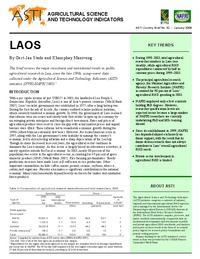Authors:
Stads, Gert-Jan; Manivong, Khamphay
Year:
2006
Publisher
International Food Policy Research Institute (IFPRI); and National Agriculture and Forestry Research Institute (NAFRI)
Back to:
Overall, agricultural researcher totals in Laos increased during 1998–2003, while the country’s agricultural R&D expenditures followed a more irregular trend. With the creation of NAFRI in 1999 through the amalgamation of the country’s nine existing research centers, total agricultural research spending grew immediately. It nevertheless dropped sharply in subsequent years and by 2003 had fallen 60 percent below its 1999 level (to $11 million in 2000 international dollars). This decline was less severe, however, when expressed in current Lao kip.
Government funding for agricultural R&D accounted for an average of just 5 percent of NAFRI’s total funding during 1998– 2003, which is extremely low compared with other Southeast Asian countries. However, the lack of government investment in agricultural R&D is offset by extensive donor funding, notably from Sida, IRRI-SDC, and Danida. Most donors focus on fieldrelated research programs that directly affect poverty levels and rural livelihoods. They nevertheless neglect research into new crop varieties and animal species to address farmer needs across Laos’ highly diverse production systems. Consequently, a major concern is that NAFRI’s research agenda is too donor-driven, and that the country’s overall agricultural R&D priorities are not sufficiently addressed.
A severe cut in donor funding or the cessation of current donor projects could seriously impede NAFRI’s ability to function. In this scenario, increased financial support from the national government would have to be forthcoming, or many of the gains made under donor programs could be under threat or be totally eroded. Another factor compounding efficient agricultural R&D in Laos is the lack of qualified, experienced, and motivated scientists in specific priority areas. Ten NAFRI researchers are currently pursuing PhD-level training abroad, which will have a positive impact on NAFRI’s future capacity. However, NAFRI’s extremely low salary levels could very likely be a disincentive for these newly trained researchers to continue their employment at NAFRI, especially given the lure of opportunities at international agencies or NGOs, or in the private sector, where salaries are considerably higher.
Despite all this, agricultural R&D in Laos has actually made quite some progress in recent years, considering the fact that Laos is one of Asia’s poorest countries and one with a recent socialist and violent past. The last couple of years have seen the establishment of NAFRI, a move towards demand-driven and participatory research, a strong focus on poverty alleviation and rural livelihoods, and efforts to develop researcher qualifications under constrained financial and recruitment conditions.

